Maryland is a Mid-Atlantic state well-known for abundant waterways and coastlines on the Chesapeake Bay and the Atlantic Ocean. The state has outsized mammal discoveries in American history regardless of its size. Formal scientific fossil discovery dates from the early Cambrian period to the end of the Cenozoic Era.
Maryland is unique in that its prehistory alternated between long periods of high and dry plains and forests and equally long periods of a shallow sea covering the state.
The ancient marine life of Maryland included bryozoans and brachiopods. Mastodons lived in the area during the Ice Age. Read on for more information on the essential dinosaurs and other prehistoric animals that once lived in Maryland.
1. Propanoplosaurus
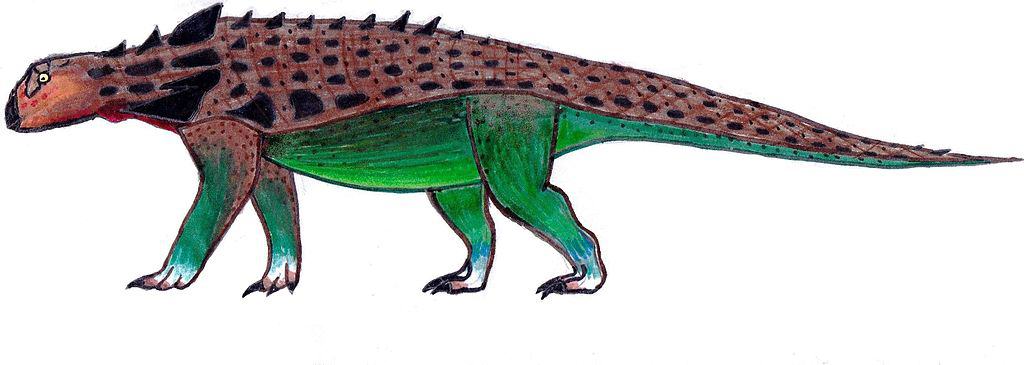
Propanoplosaurus was an extinct nodosaurid dinosaur from the Early Cretaceous period.
©Danny Cicchetti / CC BY-SA 3.0 – License
| Propanoplosaurus | |
|---|---|
| Kingdom | Animalia |
| Phylum | Chordata |
| Clade | Dinosauria |
| Order | Ornithischia |
| Clade | Thyreophora |
| Suborder | Ankylosauria |
| Clade | Euankylosauria |
| Family | Nodosauridae |
| Genus | Propanoplosaurus |
| Species | Propanoplosaurus marylandicus |
| Living period | Early Cretaceous period |
Propanoplosaurus was an extinct nodosaurid dinosaur from the Early Cretaceous period. Its fossils were discovered in Maryland’s Patuxent Formation. The remains were not only the first undisputed nodosaur to be excavated on the eastern seaboard but also the first-ever dinosaur hatchling to be discovered in this region of the United States. It measured about one foot from head to tail. It’s unclear how big a Propanoplausaurus would have been when fully grown.
Based on fossil analysis, the skull displayed osteoderms, suggesting it was a typical developmental stage of all nodosaurids. It also had a longer part in the middle of its snout, which was marked by a clear cross-pattern in the bone plates. This pattern was probably made by the triangular osteoderms.
2. Cetotherium
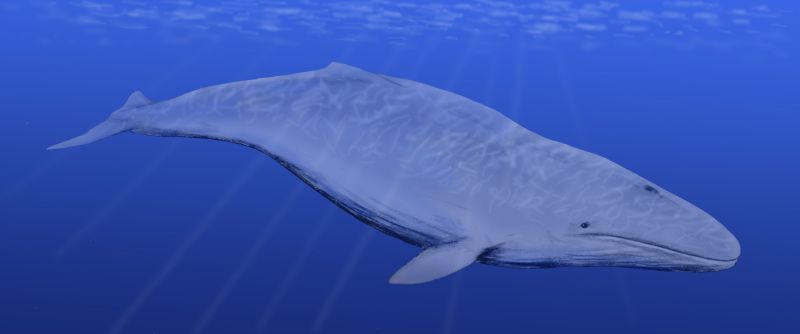
Cetotherium was considered a smaller version of the modern gray whale.
©Nobu Tamura (http://spinops.blogspot.com) / CC BY 3.0 – License
| Cetotherium | |
|---|---|
| Kingdom | Animalia |
| Phylum | Chordata |
| Class | Mammalia |
| Order | Artiodactyla |
| Infraorder | Cetacea |
| Family | Cetotheriidae |
| Subfamily | Cetotheriinae |
| Genus | Cetotherium |
| Living period | Late Oligocene to the Early Pleistocene |
Cetotherium is an extinct member of baleen whales from the late Oligocene to the Early Pleistocene. It was considered a smaller version of the modern gray whale, about one-third the length of its famous descendant.
A Cetotherium specimen, which dates back to about five million years ago, was discovered in Maryland. Fossil analysis has revealed a predator-prey relationship between the Cetotheriids and large sharks.
3. Ecphora
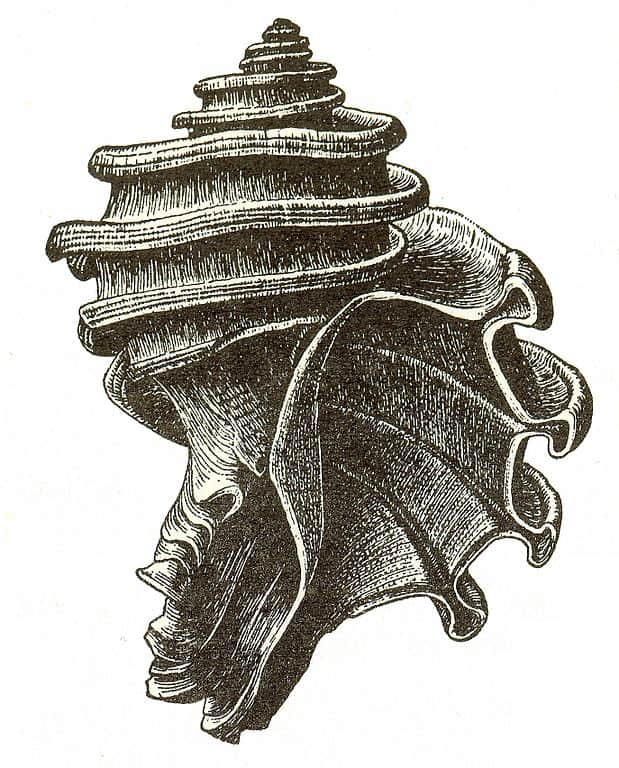
Ecphora is an extinct predatory marine gastropod mollusk from the Late Eocene period.
©Ecphora / public domain – License
| Ecphora | |
|---|---|
| Kingdom | Animalia |
| Phylum | Mollusca |
| Class | Gastropoda |
| Superfamily | Muricoidea |
| Family | Muricidae |
| Subfamily | Ocenebrinae |
| Living period | From the late Eocene until their extinction during the Pliocene |
Ecphora is the official state fossil of Maryland. It’s an extinct predatory marine gastropod mollusk from the late Eocene period. Ecphora had a long, toothed “radula” that it used for penetrating the shells of other snails and sucking out the tasty guts nestled inside.
Ecphoras were indigenous to the North American Eastern Seaboard. Many Ecphora fossils have been discovered in Maryland, along with other small invertebrates of the Paleozoic Era. It’s thought that the Ecphoras were the ocenibrenine murexes that descended from the Eocene genus Tritonopsis.
4. Astrodon
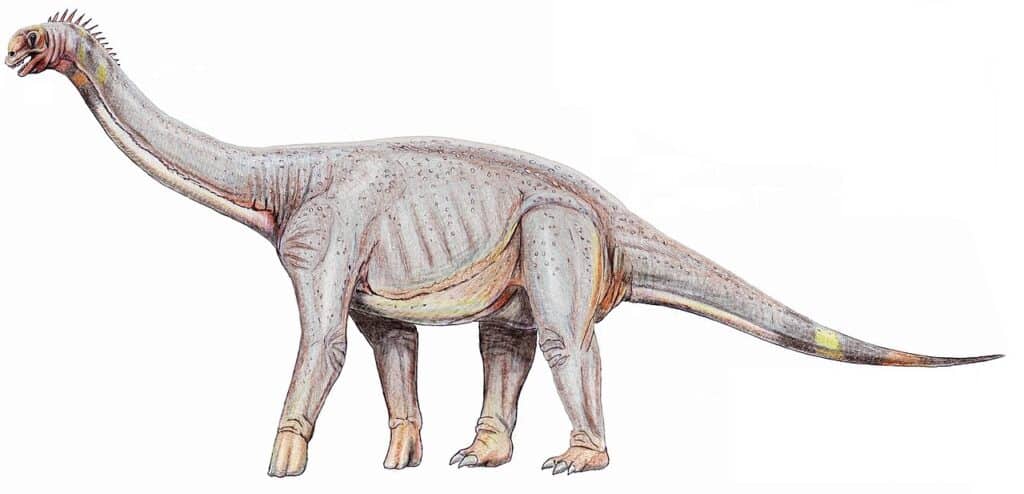
Astrodon is the official state dinosaur of Maryland.
©Dmitry Bogdanov / CC BY 3.0 – License
| Astrodon | |
|---|---|
| Kingdom | Animalia |
| Phylum | Chordata |
| Clade | Dinosauria |
| Clade | Saurischia |
| Clade | Sauropodomorpha |
| Clade | Sauropoda |
| Clade | Macronaria |
| Clade | Titanosauriformes |
| Genus | Astrodon |
| Species | Astrodon johnstoni |
| Living period | Early Cretaceous period |
Astrodon is an extinct genus of massive herbivorous sauropod dinosaurs that inhabited the eastern United States during the Early Cretaceous period. Astrodon is the official state dinosaur of Maryland. It used to be the state dinosaur of Texas but has since been replaced by Sauroposidon.
Astrodon fossils have been discovered in the Arundel Formation at Swampoodle in Maryland, which dates through palynomorphs to the Albian, about 112 million to 110 million years ago. It’s estimated that Astrodons measured about 30 feet in height and 66 feet in length. They weighed approximately 22 tons (44,000 pounds).
5. Deinonychus
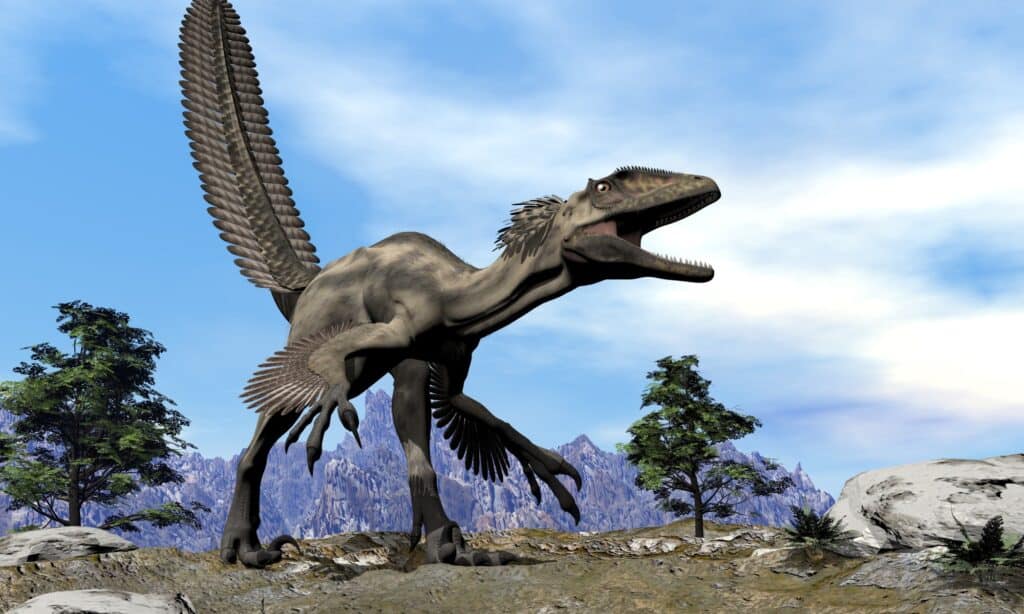
Deinonychus could grow up to 11 feet in length and 2.9 feet at hip height.
©Elenarts/Shutterstock.com
| Deinonychus | |
|---|---|
| Kingdom | Animalia |
| Phylum | Chordata |
| Clade | Dinosauria |
| Clade | Saurischia |
| Clade | Theropoda |
| Family | Dromaeosauridae |
| Clade | Eudromaeosauria |
| Subfamily | Dromaeosaurinae |
| Genus | Deinonychus |
| Living period | About 115 million to 108 million years ago |
Deinonychus is an extinct dromaeosaurid theropod dinosaur that lived during the early Cretaceous period. Its fossils have been discovered in Maryland and many other places. Based on analysis of a few complete, mature specimens, Deinonychus could grow up to 11 feet in length and 2.9 feet at hip height. It’s estimated that this species weighed approximately 161 to 220 pounds.
Deinonychus possessed robust limbs with three claws on each forelimb. The first digit was shorter, while the second was longer. Each hind foot had a distinctive sickle-shaped claw, probably used during predation. Although it’s thought that Deinonychus had feathers, no skin impressions have been identified in association with its fossils.
6. Priconodon
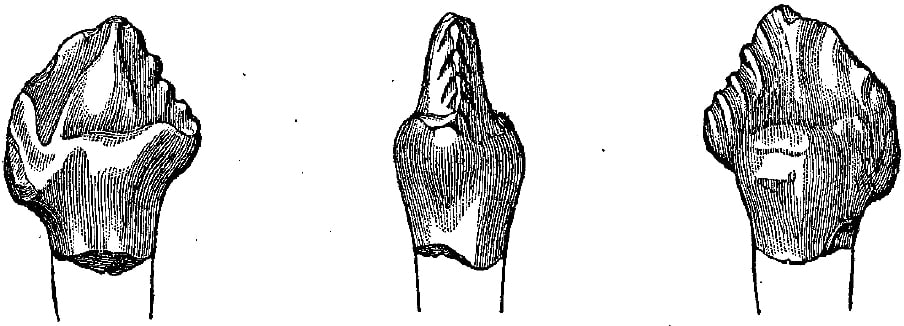
Based on fossil analysis, Priconodon may have been a slow, armored, quadrupedal herbivore.
©Marsh / public domain – License
| Priconodon | |
|---|---|
| Kingdom | Animalia |
| Phylum | Chordata |
| Clade | Dinosauria |
| Order | Ornithischia |
| Clade | Thyreophora |
| Suborder | Ankylosauria |
| Family | Nodosauridae |
| Genus | Priconodon |
| Species | Priconodon crassus |
| Living period | Cretaceous Period |
Priconodon is an extinct species of herbivorous dinosaurs that inhabited North America during the Cretaceous period. Its fossils were discovered in the Lower Cretaceous Arundel Formation and Potomac Group, both located in Maryland.
Based on fossil analysis, Priconodon may have been a slow, armored, quadrupedal herbivore. It was a large nodosaurid with huge teeth. Only Priconodon teeth have been described; size estimation has not yet been done.
7. Acrocanthosaurus
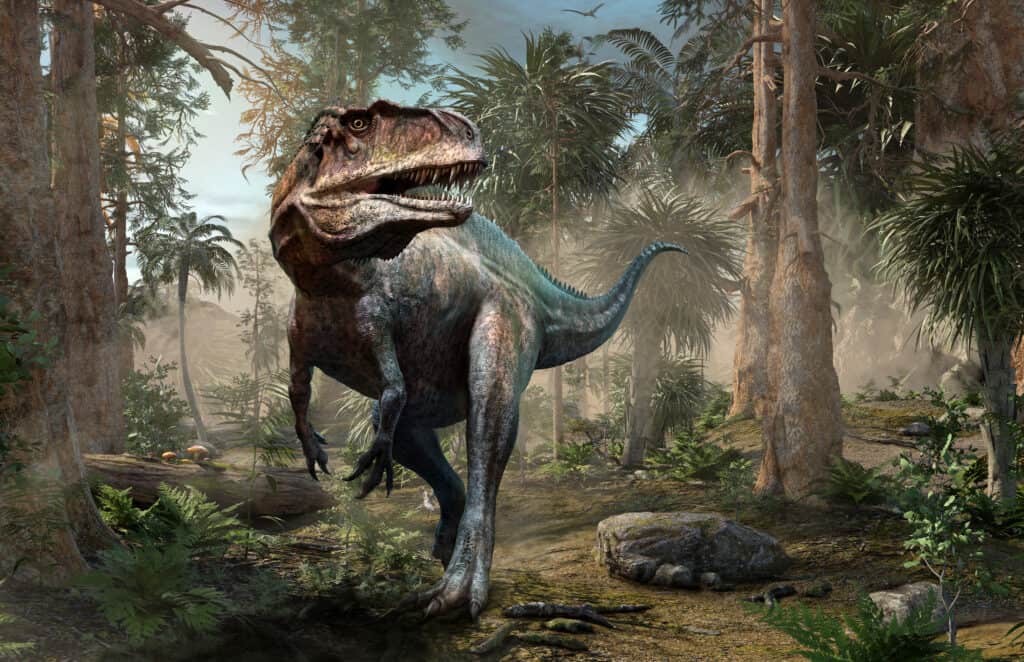
Acrocanthosaurus was one of the giant theropods that preyed on ornithopods, sauropods, and ankylosaurs.
©Warpaint/Shutterstock.com
| Acrocanthosaurus | |
|---|---|
| Kingdom | Animalia |
| Phylum | Chordata |
| Clade | Dinosauria |
| Clade | Saurischia |
| Clade | Theropoda |
| Family | Carcharodontosauridae |
| Genus | Acrocanthosaurus |
| Living period | Early Cretaceous, about 113 million to 110 million years ago |
Acrocanthosaurus was an extinct genus of carcharodontosaurid dinosaurs that lived in North America during the Early Cretaceous period. Large Acrocanthosaurus fossils and footprints were found in Texas, while the teeth attributed to this creature were discovered in Maryland.
Acrocanthosaurus was one of the giant theropods that preyed on ornithopods, sauropods, and ankylosaurs. It’s estimated that the most notable species grew up to 36 feet in length and weighed approximately 8,000 to 9,800 pounds (4 to 4.9 tons).
Like most allosauroids, the skull of Acrocanthosaurus was long, low, and narrow. It had nineteen curved, serrated teeth on each side of the upper jaw. The tooth count for the lower jaw has not yet been established. Like other non-avian theropods, Acrocanthosaurus’ forelimbs didn’t touch the ground, so they didn’t use them for locomotion; they only served a predatory function.
8. Tenontosaurus
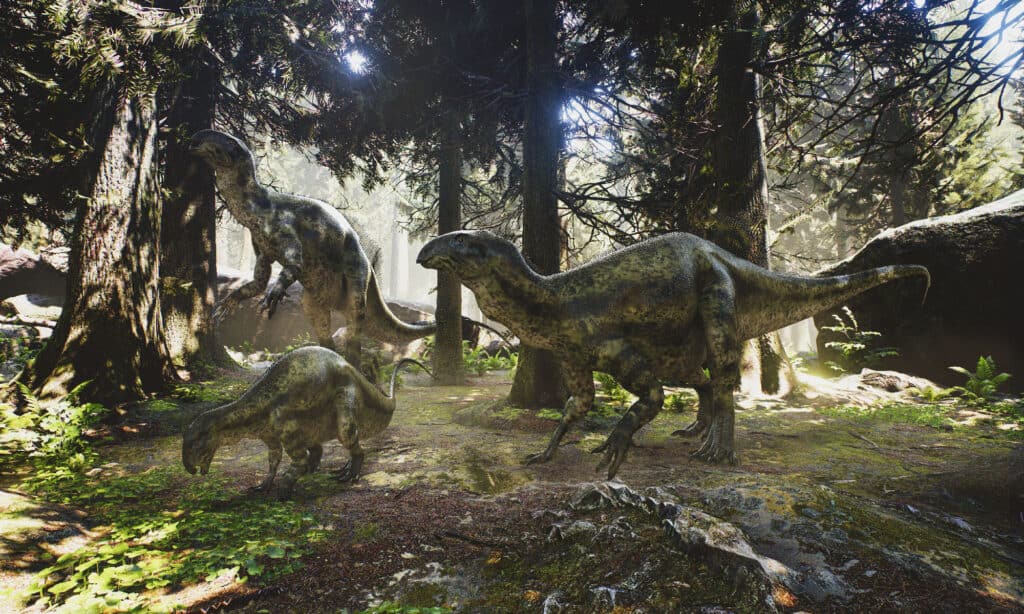
Tenontosaurus weighed between 1,300 to 2,200 pounds.
©Herschel Hoffmeyer/Shutterstock.com
| Tenontosaurus | |
|---|---|
| Kingdom | Animalia |
| Phylum | Chordata |
| Clade | Dinosauria |
| Order | Ornithischia |
| Clade | Ornithopoda |
| Clade | Iguanodontia |
| Genus | Tenontosaurus |
| Living period | Early Cretaceous, about 115 million and 108 million years ago |
Tenontosaurus was an extinct ornithopod dinosaur that lived in North America from the late Aptian to Albian ages of the Early Cretaceous period. It was a medium-to-large-sized creature, that measured approximately 20 to 23 feet long, and weighed between 1,300 to 2,200 pounds. It had a long, broad tail with a distinct network of bony tendons.
Adult tenontosaurus was a low browser, while juveniles fed on low-growing ferns and shrubs. It had a powerful, U-shaped beak and angled cutting teeth surfaces that facilitated its browsing habits. Tenontosaurus was not limited to which part of the plant it consumed. It’s thought that leaves, fruit, or even wood may all have formed part of the Tenontosaurus diet.
The photo featured at the top of this post is © Elenarts/Shutterstock.com
Thank you for reading! Have some feedback for us? Contact the AZ Animals editorial team.






